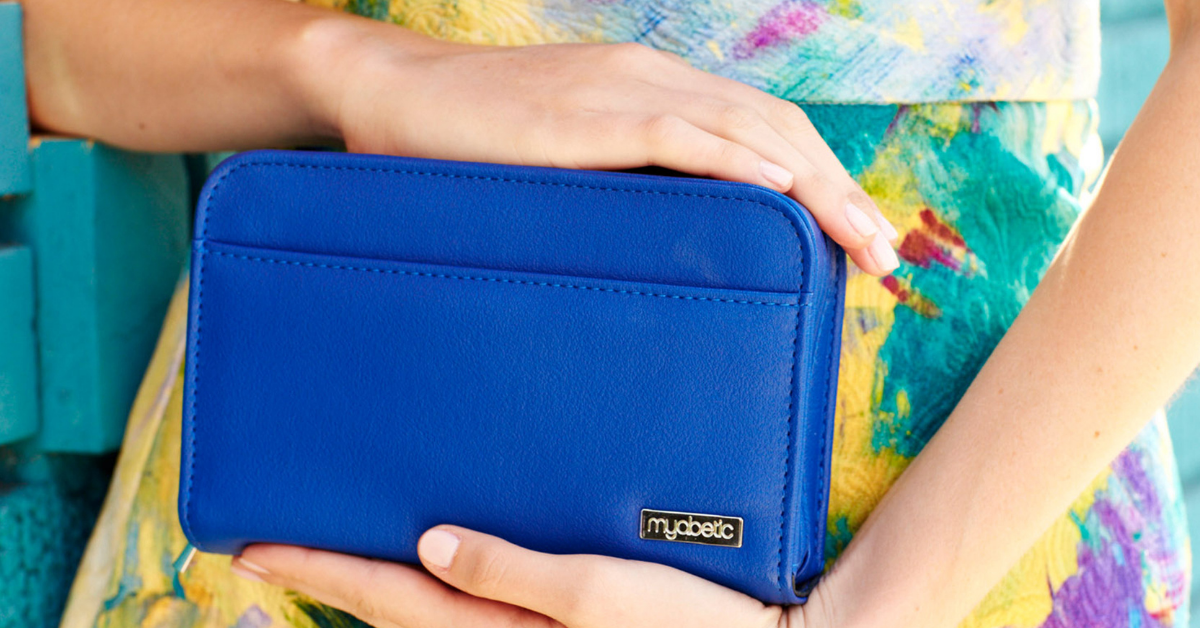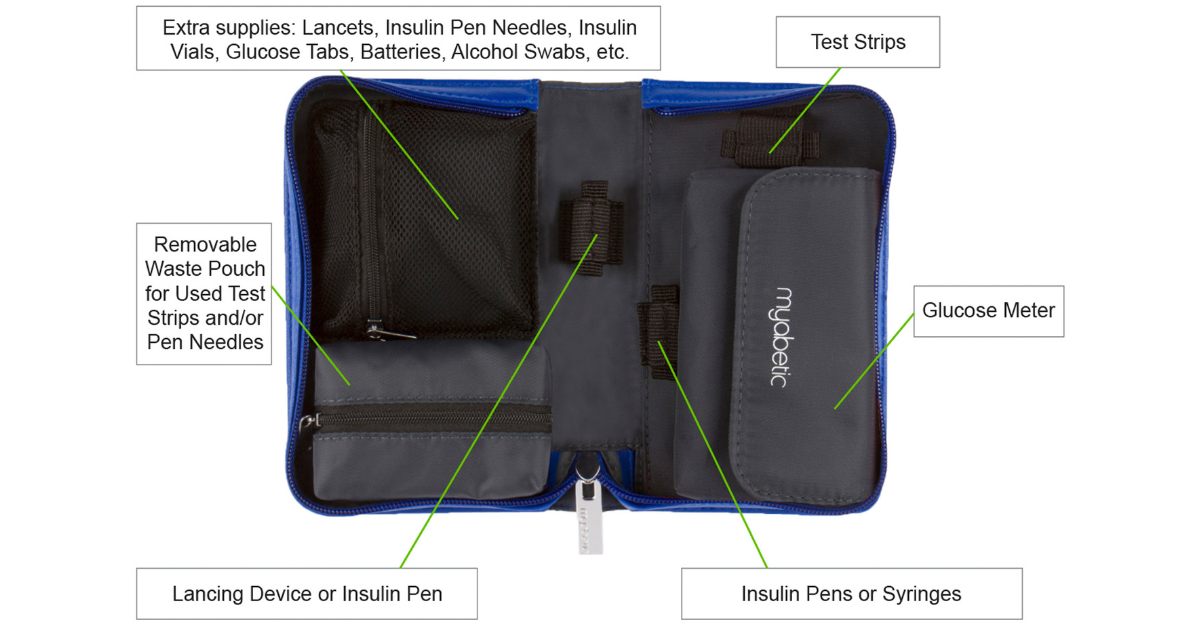
Diabetes wallets and bags offer a stylish, compact way to organize your diabetes supplies and ensure that you have everything you need to manage your condition. Diabetes wallets have compartments for insulin, used test strips, and other supplies to help keep you organized.
If you have diabetes, you know that managing the condition can sometimes feel like having a baby. You have to stick to a strict schedule, carefully manage your diet, and carry around tons of supplies everywhere you go. People who use insulin have a lot of loose items they need to bring around with them like the vials, alcohol pads, and syringes, but even those who do not use insulin can find that their blood glucose meter, medications, and other tools can also be cumbersome.
We all take advantage of purses and backpacks for our other belongings, so it makes sense that many people with diabetes can benefit from using a diabetes wallet or bag to organize and store their supplies while on the go. There are numerous benefits of a diabetes wallet when it comes to managing your condition.
What is a diabetes wallet?
A diabetes wallet is a type of diabetes organizer. Others include fanny packs, carrying cases, pouches and purses that are custom designed to store and organize your diabetes supplies. Depending on the size of the diabetes organizer you choose, you may be able to store just the essentials, or everything you need plus extra supplies.
What are the benefits of a diabetes organizer?
Diabetes organizers have many benefits for people with diabetes.
First, they offer a stylish storage solution for your testing supplies. You can find diabetes organizers in a variety of styles, colors, and sizes, so there is an option for everyone. If a wallet isn’t for you, check out some of the other diabetes organizer options listed above.
You are also able to securely store your diabetes supplies in one place. Diabetes wallets and other organizers are specifically designed with compartments for each of the supplies people will commonly need to carry with them, and many even include an extra pouch for used test strips or sharps to allow for safe disposal. By keeping your supplies organized and compartmentalized, it’s easy to see which supplies need to be replenished before you leave the house.
Some organizers even feature an insulated section that can be used with a cold pack to keep your insulin and other temperature-sensitive supplies at a safe temperature. If you’ve ever tried to travel through the airport with your diabetes management supplies in tow, you know how important it is to have your supplies organized for the security check by TSA. With a travel-specific diabetes organizer, you won’t have to worry about getting held up at security; everything is organized, visible, and ready to help you breeze through the checkpoint.

What supplies can a diabetes organizer hold?
No two people with diabetes are exactly the same, and each person may use different supplies. For example, a person who uses insulin injections to manage their diabetes will need different supplies than someone who just takes oral medication. Therefore, diabetes organizers come in a variety of different sizes and designs to meet the needs of each individual patient. In general, a standard size diabetes organizer can store and organize the following supplies.
Glucose meter and test strips
Having the supplies with you to check your blood sugar level is critical. Even patients who use constant glucose monitors (CGMs) should carry a glucose meter and test strips because CGMs can fail and are sometimes not as accurate as a glucose meter, such as when your blood sugar level is rapidly rising or falling, due to the delay between the actual level of glucose in your blood and the time it takes to affect your interstitial fluids.
Keeping your blood sugar at the right level is critical for the health and safety of you and everyone around you, so you’ll need a way to carry enough test strips to make it through at least one to two days. A diabetes organizer not only provides space for you to store your glucose meter and test strips, it also can include a removable waste pouch to gather used test strips and lancets for proper disposal later.
Lancing device and lancets
In order to test your blood sugar, you’ll need your lancing device and the lancets themselves to prick your finger and draw blood. It’s important to use a new lancet each time to prevent infection, so you’ll need to carry several with you at all times in case the unexpected occurs. You can store the lancing device and lancets along with your glucose monitor kit in your diabetes organizer.
Insulin
One of the most important supplies for many people with diabetes is insulin. People who are insulin-dependent for diabetes management can find themselves in a dangerous situation if they forget to bring their insulin with them when they leave the house.
There are two primary types of insulin: long-acting insulin and fast-acting insulin. Long-acting insulin is designed to provide a slow, steady release of insulin, generally with a half-life of about 24 hours, helping to manage blood sugar between meals and during the night. Rapid-acting insulin is typically administered before, during, or after a meal to manage blood sugar levels that change as a result of food intake.
People who use an insulin pump typically use only rapid-acting insulin, as the pump provides a steady stream of insulin throughout the day, but they may want to have long-acting insulin on hand as a backup. Some people use a combination of long-acting and rapid-acting insulin to manage their diabetes, while other people use just one or the other.
Insulin should be stored at no more than room temperature, so it can’t be left in the car during extreme temperatures. As a result, patients who need insulin need to carry their supplies with them, which makes a diabetes organizer extremely handy. Failure to administer insulin when needed can cause life-threatening blood glucose levels.
Syringes or insulin pen needles
For those who don’t use an insulin pump, insulin is administered through the use of syringes or pen needles, so carrying your insulin isn’t very helpful if you don’t have the supplies you need to give yourself an injection. It’s not enough to plan on giving yourself one injection while you’re away from your house because you never know what delays could occur that keep you away from your home longer than planned.
As a result, it’s recommended that people who require insulin injections keep at least six syringes or pen needles with them at all times. Plan ahead to stay safe and healthy.
Oral medication or non-insulin injectables
Not everyone uses insulin to manage their diabetes, and some people who do use insulin also take oral medications or use non-insulin injectables with their meals. A diabetes organizer provides a place to keep several pills or non-insulin injectables with you in easy reach in case you unexpectedly find yourself eating a meal while away from the house or staying the night at a friend’s or relative’s.
Insulin pump supplies
People who use an insulin pump or pod system can experience technical difficulties while away from home. If you use an insulin pump or pod system, make sure to store a backup infusion site or pod in your diabetes organizer along with some alcohol pads or swabs.
Fast-acting carbohydrates or glucose
Just as high blood sugar can be extremely dangerous, so can low blood sugar, and people who take insulin or other medications to manage blood sugar levels can experience dramatic drops in their blood sugar.
People with diabetes who use blood sugar lowering medications should always keep fast-acting carbohydrates or fast-absorbing glucose with them, and you can store them in your diabetes organizer along with your other supplies. Remember that some of these items, such as gummy candies, can be temperature-sensitive, so you don’t want to leave them in your car in extreme temperatures in the peak of summer or winter.
Cold pack
If you use insulin or other temperature-sensitive items, you’ll want to make sure that your diabetes organizer has a spot to insert a cold pack. Temperature-sensitive items like insulin and your glucose meter can’t be stored in your car in very hot or very cold weather, so keeping a cold pack with these items can help keep your medication and meter safe.
The takeaway
Staying organized and making sure that you have the right supplies with you no matter where you go is critical to staying safe and healthy. Fortunately, diabetes organizers make it easy to carry your supplies with you wherever life takes you.
Whether you prefer to keep large quantities of your supplies plus plenty of backups or you’d prefer to carry just the basics most of the time, there is a diabetes organizer out there that suits your needs and won’t cramp your style.
Check out Diathrive’s collection of diabetes organizers, including wallets, carrying cases, and bags here. You’re sure to find one that fits exactly what you need!
